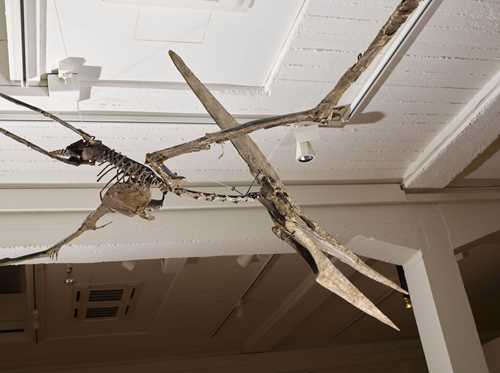
Lot 1881* - S17 Out of This World - Tuesday, 28. June 2022, 04.00 PM
PTERANODON LONGICEPS FULL SKELETON IN FLYING POSITION
Niobrara Region, Western Kansas (USA)
Upper Cretaceous, around 70-85 million years
Wingspan: 302 cm
Length of skull: 127 cm
Total dimensions: 302 x 181 x 120 cm
Ready for display on ceiling
Upper Cretaceous, around 70-85 million years
Wingspan: 302 cm
Length of skull: 127 cm
Total dimensions: 302 x 181 x 120 cm
Ready for display on ceiling
Provenance: Swiss private collection
What a breathtaking sight it must have been when these incredible creatures rose into the air. The huge leathery wings helped them to skilfully use the lift in the air above the sea.
These wonderful flying reptiles evolved in the Interior Sea of western North America. Paleotologists presume they were able to fly large distances and were skillful fishers and devoted parents. Males were larger than females, with a maximum wingspan of about 7 meters. Their long toothless beaks were used to fish, not unlike a modern pelican does. The pterosaurus‘ bones, particularly the wings, are hollow, light, and very thin, which makes them perfectly tuned to fly. Also, the Pteranodon‘s back interior vertebraes are cound in a block solid enough to support the rib cage and large wings.
Pteranodon was the first pterosaur found outside of Europe. Its fossils first were found by Othniel Charles Marsh in 1871, in the Late Cretaceous Smoky Hill Chalk deposits of western Kansas. These chalk beds were deposited at the bottom of what was once the Western Interior Seaway, a large shallow sea over what now is the midsection of the North American continent.
The specimen presented here is in fantastic condition with over 70% of the original bone material showing. The skull is measuring an impressive 123 cm.
On the skeleton, the right wing is almost completely original, except for some small bone fragments. Large parts of the beak and the neck also are original, as well as the legs. The accompanying sketch shows the original bones (in red) and the reconstructed parts.
The skeleton comes in six, easy to assemble parts.
- For customers in Switzerland, transport and personal help with installing the skeleton is included.
- For customers in Europe, personal help with installing the skeleton is included.
- For customers worldwide we can assist via a Zoom call.
What a breathtaking sight it must have been when these incredible creatures rose into the air. The huge leathery wings helped them to skilfully use the lift in the air above the sea.
These wonderful flying reptiles evolved in the Interior Sea of western North America. Paleotologists presume they were able to fly large distances and were skillful fishers and devoted parents. Males were larger than females, with a maximum wingspan of about 7 meters. Their long toothless beaks were used to fish, not unlike a modern pelican does. The pterosaurus‘ bones, particularly the wings, are hollow, light, and very thin, which makes them perfectly tuned to fly. Also, the Pteranodon‘s back interior vertebraes are cound in a block solid enough to support the rib cage and large wings.
Pteranodon was the first pterosaur found outside of Europe. Its fossils first were found by Othniel Charles Marsh in 1871, in the Late Cretaceous Smoky Hill Chalk deposits of western Kansas. These chalk beds were deposited at the bottom of what was once the Western Interior Seaway, a large shallow sea over what now is the midsection of the North American continent.
The specimen presented here is in fantastic condition with over 70% of the original bone material showing. The skull is measuring an impressive 123 cm.
On the skeleton, the right wing is almost completely original, except for some small bone fragments. Large parts of the beak and the neck also are original, as well as the legs. The accompanying sketch shows the original bones (in red) and the reconstructed parts.
The skeleton comes in six, easy to assemble parts.
- For customers in Switzerland, transport and personal help with installing the skeleton is included.
- For customers in Europe, personal help with installing the skeleton is included.
- For customers worldwide we can assist via a Zoom call.
翼龙长腿在飞行状态下的完整骨架
堪萨斯州西部的Niobrara地区(美国)上白垩纪,约7000-8500万年前翼展: 302 厘米颅骨的长度: 127 厘米整体尺寸: 302 x 181 x 120 厘米
出处:瑞士私人收藏当这些不可思议的生物飞上天空时,那一定是一个令人惊叹的景象。巨大的皮质翅膀帮助它们巧妙地利用海面上空的浮力。这些飞行爬行动物主要在北美洲西部进化。古人类学家认为,他们能够飞行很远的距离,而且他们是熟练的渔民和忠实的父母。雄鸟比雌鸟大,最大翼展约为7米。它们长而无牙的喙被用来捕鱼,很像现代的鹈鹕。翼龙的骨头,特别是翅膀,是中空的,很轻,很薄,使它们非常适合飞行。此外,翼龙的后部内侧椎骨连接成一个整体,足以稳定地支撑胸部和大翅膀。翼龙是在欧洲以外发现的第一只 翼龙目动物。它的化石于1871年由Othniel Charles Marsh在堪萨斯州西部Smoky Hill的白垩纪沉积中首次发现。它们沉积在前西部内陆海道的地面上,该海道是在现在的北美大陆中部上空的一个大型浅海。这里展示的标本状况非常好,有超过70%的原始骨料被保存下来。这个头骨的尺寸令人印象深刻,达到了123厘米。在骨架上,除了一些骨头碎片外,右翼几乎完全是原始的。头骨和颈部的大部分也是原件,腿部也是如此。这里展示的草图显示了原始骨骼(红色)和重建的部分。
CHF 120 000 / 200 000 | (€ 123 710 / 206 190)
Sold for CHF 378 500 (including buyer’s premium)
All information is subject to change.












